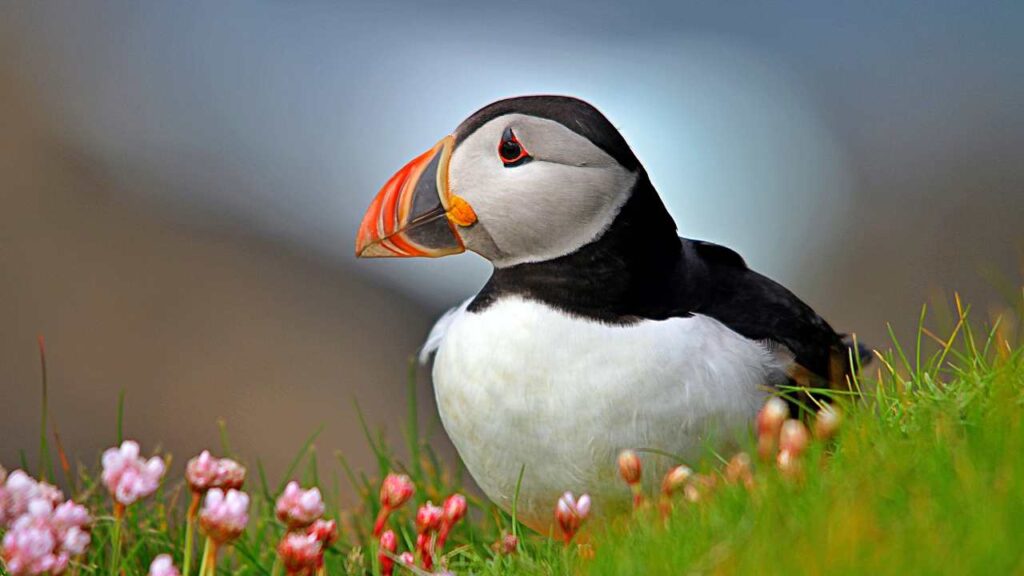The puffin bird, with its distinctive appearance and charming personality, is one of the most captivating seabirds in the world. These charismatic birds are known for their brightly colored bills, striking plumage, and comical demeanor. In this blog post, we’ll dive deep into the world of puffins, exploring their habitat, behavior, and significance in the ecosystem.

Anatomy and Appearance
Puffins are medium-sized seabirds belonging to the family Alcidae. There are three species of puffins: the Atlantic puffin, the horned puffin, and the tufted puffin. Among these, the Atlantic puffin is the most famous.
Physical Characteristics
- Colorful Bills: Puffins are easily recognizable by their colorful bills, which feature vibrant orange, yellow, and blue hues during the breeding season. These bills play a crucial role in attracting mates and are also used for catching fish.
- Plumage: Puffins have black and white plumage on their bodies, which provides effective camouflage when they swim underwater. During the breeding season, their facial plumage becomes more vibrant, with rosette-shaped markings around their eyes.
- Size: On average, puffins measure between 25 to 30 centimeters (10 to 12 inches) in length. They typically have a wingspan of 50 to 60 centimeters (20 to 24 inches) and weigh between 300 to 500 grams (10 to 17 ounces).
Habitat and Distribution
Puffins are primarily found in the northern hemisphere, inhabiting coastal regions of the North Atlantic and North Pacific Oceans. They are known to breed in a few select locations, which include:
- Atlantic Puffin: These puffins are found along the coastlines of the North Atlantic, including regions like Iceland, Norway, the British Isles, and North America.
- Horned Puffin: This species is mainly seen along the west coast of North America, including Alaska and parts of Siberia.
- Tufted Puffin: Tufted puffins are commonly found in the North Pacific, with breeding colonies along the coasts of Alaska, British Columbia, and Siberia.
Behavior and Diet
Puffins are highly skilled flyers and swimmers, making them well-suited for their marine lifestyle. Some interesting aspects of their behavior include:
- Diet: Puffins are piscivores, which means they primarily feed on fish. They are skilled hunters, using their strong wings to dive underwater and catch fish, such as herring and sand eels.
- Breeding: Puffins are monogamous and often return to the same nesting sites year after year. They dig burrows in cliffs or use rock crevices to create their nests, where they lay a single egg.
- Molt Migration: After the breeding season, puffins undergo a molting process where they shed their old feathers and grow new ones. During this time, they migrate away from their breeding colonies to open waters.
Conservation Status
Puffin populations face various threats, including habitat destruction, overfishing, and climate change. The International Union for Conservation of Nature (IUCN) lists several puffin species as vulnerable or near-threatened. Conservation efforts are crucial to protect these charismatic seabirds and their habitats.
Frequently Asked Questions (FAQ)
Why are puffins called “clowns of the sea”?
Puffins earned this nickname due to their comical appearance. Their colorful bills, distinctive facial markings, and waddling walk give them a humorous and endearing quality, making them seem like the clowns of the ocean.
How deep can puffins dive for food?
Puffins are excellent divers and can reach depths of up to 60 meters (200 feet) in search of prey.
Are puffins good fliers?
Yes, puffins are skilled flyers. They have strong, rapidly beating wings that allow them to travel up to 55 miles per hour (90 kilometers per hour).
How do puffins protect their nests?
Puffins often choose nesting sites on cliffs or rocky islands, which provide natural protection from predators. They also defend their nests vigorously if intruders approach.
Do puffins mate for life?
Puffins are known for forming long-term monogamous bonds with their mates. They often return to the same nesting site and mate with the same partner each breeding season.
